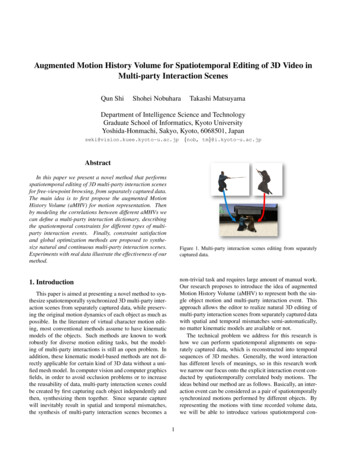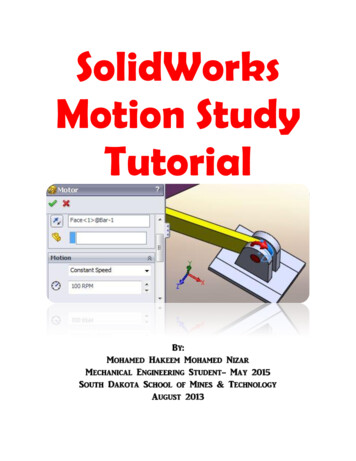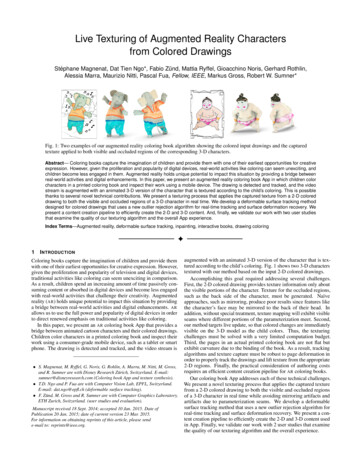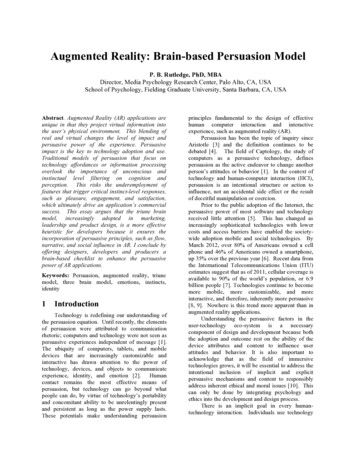
Transcription
Augmented Motion History Volume for Spatiotemporal Editing of 3D Video inMulti-party Interaction ScenesQun ShiShohei NobuharaTakashi MatsuyamaDepartment of Intelligence Science and TechnologyGraduate School of Informatics, Kyoto UniversityYoshida-Honmachi, Sakyo, Kyoto, 6068501, Japanseki@vision.kuee.kyoto-u.ac.jp {nob, tm}@i.kyoto-u.ac.jpAbstractIn this paper we present a novel method that performsspatiotemporal editing of 3D multi-party interaction scenesfor free-viewpoint browsing, from separately captured data.The main idea is to first propose the augmented MotionHistory Volume (aMHV) for motion representation. Thenby modeling the correlations between different aMHVs wecan define a multi-party interaction dictionary, describingthe spatiotemporal constraints for different types of multiparty interaction events. Finally, constraint satisfactionand global optimization methods are proposed to synthesize natural and continuous multi-party interaction scenes.Experiments with real data illustrate the effectiveness of ourmethod.Figure 1. Multi-party interaction scenes editing from separatelycaptured data.non-trivial task and requires large amount of manual work.Our research proposes to introduce the idea of augmentedMotion History Volume (aMHV) to represent both the single object motion and multi-party interaction event. Thisapproach allows the editor to realize natural 3D editing ofmulti-party interaction scenes from separately captured datawith spatial and temporal mismatches semi-automatically,no matter kinematic models are available or not.The technical problem we address for this research ishow we can perform spatiotemporal alignments on separately captured data, which is reconstructed into temporalsequences of 3D meshes. Generally, the word interactionhas different levels of meanings, so in this research workwe narrow our focus onto the explicit interaction event conducted by spatiotemporally correlated body motions. Theideas behind our method are as follows. Basically, an interaction event can be considered as a pair of spatiotemporallysynchronized motions performed by different objects. Byrepresenting the motions with time recorded volume data,we will be able to introduce various spatiotemporal con-1. IntroductionThis paper is aimed at presenting a novel method to synthesize spatiotemporally synchronized 3D multi-party interaction scenes from separately captured data, while preserving the original motion dynamics of each object as much aspossible. In the literature of virtual character motion editing, most conventional methods assume to have kinematicmodels of the objects. Such methods are known to workrobustly for diverse motion editing tasks, but the modeling of multi-party interactions is still an open problem. Inaddition, these kinematic model-based methods are not directly applicable for certain kind of 3D data without a unified mesh model. In computer vision and computer graphicsfields, in order to avoid occlusion problems or to increasethe reusability of data, multi-party interaction scenes couldbe created by first capturing each object independently andthen, synthesizing them together. Since separate capturewill inevitably result in spatial and temporal mismatches,the synthesis of multi-party interaction scenes becomes a1
straints for multiple objects, based on which a multi-partyinteraction dictionary can be defined. Then for each interaction scene, rather than computing an individual frame,the aMHV considers a duration of motion simultaneously incomputation. This makes it possible to consider spatiotemporal constraints on the entire motion, and to have objectivecriteria that describe entire motions. Thus for each interaction scene we can acquire a solution group with multiplereasonable relative locations of the two interacting objectsby performing aMHV-based constraint satisfaction, whilepreserving the original motion of each object.The overall processing scheme of the proposed methodis as follows. Given two separately captured motion sequences, we first perform data segmentation and temporalalignment. Then we build up the aMHV for each motionsegment in a multi-party interaction scene. Next, we decide the spatiotemporal constraints for each interactive motion segment pair and compute the solution group to realize the editing of each single interaction scene. Finally allthe edited interaction scenes will be integrated together under a global optimization strategy. Figure 2 illustrates thecomputational processes of our method. It should be notedthat step 3, 5, 6, 7 can be computed automatically using theproposed method, while step 4 requires some manual workfrom the editor. The two pre-processing steps are out of thescope of this article, and they could be done using conventional methods.The main contributions of this paper consist of (1) wehave augmented the original Motion History Volume [15]by encoding more temporal information and assigning labels onto its surfaces, (2) we have designed a novel methodthat models multi-party interaction events into an interaction dictionary, based on the aMHV. The possible applications include the making and editing of movies, computeranimations and video games.The rest of this paper is organized as follows. First, wereview related studies to clarify the novelty of this work inSection 2. We then introduce our aMHV-based multi-partyinteraction representation in Section 3, and the intra-keysegment editing and inter-key segment optimization algorithm in Section 4. Evaluation of our method with real datais given in Section 5. Finally, we summarize the proposedmethod in Section 6.ment of commercial tools.For editing a single object, motion warping [1, 2] hasbeen widely applied to preserve the original features of input motion data while satisfying a new set of constraintsas much as possible. Using structurally similar motiondatabase, Mukai et al. [3] have proposed a motion interpolation approach to obtain continuous spans of high qualitymotion. Some other researchers combined an interpolationtechnique with motion graphs to allow parametric interpolation of motion while traversing the graph [4, 5]. While theseworks are proved to work robustly for editing single objectmotions, they did not provide any constraints for editingmulti-party interaction events.Besides, Zordan et al. [6] have introduced a techniquefor incorporating unexpected impacts into a motion capturedriven animation system through the combination of a physical simulation and a specialized search routine. Ye et al. [7]have proposed a fully automatic method that learns a nonlinear probabilistic model of dynamic responses from veryfew perturbed sequences. Their model is able to synthesizeresponses and recovery motions under new perturbationsdifferent from those in the training examples. Althoughthese methods can somehow, work for very short interactive events, they are performing the editing by changing theoriginal motion dynamics instead of keeping it, and they arenot applicable for editing long and continuous multi-partyinteraction scenes either.In this paper, we are presenting a novel spatiotemporalediting framework that synthesize well synchronized multiparty interaction scenes from separately captured data,in which objects are performing interactive motions thatshould match with each other, respectively.2.2. Motion representation approachesIn computer graphics and computer vision area, researchers have invented various approaches for describingmotions.Positions and velocities of human body parts have beenused by Green et al. [8] for human movement recognition.Optical flows [9], motion templates [10] and space-timevolumes [11, 12] are also widely used for solving tracking and recognition problems. Such methods are mainlyused for describing the objects motion features for recognition tasks, and they do not offer any controllable factors formotion editing task. Besides, kinematic models [6, 13] arewidely used in robotics, motion capture system and computer animation editing. They can represent variety kind ofmotions, and as well they provide easily controllable factorsfor the editors. However, the kinematic models are lackingin the ability of representing multi-party interaction events.Few spatiotemporal constraints can be directly defined between multiple objects based on them. Not to mention thatfor certain type of unstructured data [14] without a unified2. Related Work2.1. Motion editing work for computer animationThe proliferation of various techniques for creating motions for visual media products, coupled with the needs tobest utilize these artistic assets, has made motion editing arapidly developing area of research and development. Thepast few years have witnessed an explosion of new techniques for various motion editing tasks, as well as deploy2
Figure 2. Computational processes for multi-party interaction editing.mesh model, kinematic structures are not applicable at all.On the other hand, the idea of Motion History Volumehas been proposed by Weinland [15], for solving free viewpoint action recognition task. It carries out a concept ofconsidering the entire motion as a whole instead of describing it for each single frame, by encoding the historyof motion occurrences in the volume. Voxels are thereforemultiple-values encoding how recently motion occurred ata voxel. Mathematically, consider the binary-valued function D(x, y, z, t) indicating motion at time t and location(x, y, z), then their MHV function is defined as follows:(τif D(x, y, z, t)vτ (x, y, z, t) max(0, vτ (x, y, z, t 1) 1) otherwise(1)where τ is the maximum duration a motion is stored.Our work proposed an augmentation of the originalMHV by recording precisely the full temporal informationof motion, making it more suitable for multi-party interaction editing tasks.3. Definition of aMHV and multi-party interaction dictionaryIn this section, we first propose an augmentation of theoriginal Motion History Volume by adding in full temporalinformation of the motion. Then an aMHV based multiparty interaction representation method will be given aswell.3.1. aMHV of individual motionAs is written in Section 2.2, the idea of motion historyvolume was invented for action recognition, and has beenproved to be effective. However, the original definition ofMHV only cares about the occurrence of the motion, whichmay not be enough for performing multi-party interactionediting. Since we need to do spatial and temporal alignments of multiple separately captured motion sequences,3(a) aMHV of the at- (b) aMHVtacker.dodger.oftheFigure 3. Examples of aMHV.full temporal information including both the starting andending moments of the motion is necessary for representing the spatiotemporal correlations between multiple objects motions. Therefore, we extend the definition of MHVby adding in more temporal information of the motion asfollows:(Sτ 1(tstart , tend ) if i 0 D(x, y, z, i)vτ (x, y, z, t) N ullotherwise(2)where tstart and tend are the starting and ending time ofthe motion. And we denote the center of gravity of aMHVvτAi (x, y, z, t) as CiA (x, y, z), which is considered as theroot node of an aMHV.Figure 3 illustrates the aMHVs of the attacker and thedodger in a fighting scene, respectively. Here different colors represent different ending time of the motion on the voxels.It should be noted that aMHV needs not necessarily contain the motion of the entire body. Instead it can be simplified by only counting in the partial volume of interest onthe objects body. For example, in a sword fighting scenewe may only care about the weapon of the attacker, so thatan aMHV of the sword would be enough for further editingwork.
(a) If interest volumes contact with each other at everymoment within ττ\ 1(Vt0A (x, y, z) Vt0B (x, y, z) 6 φ)(5)t 0(b) If interest volumes contact with each other at certainmoments within τFigure 4. Lables of aMHV surfaces.τ[ 1(Vt0A (x, y, z) Vt0B (x, y, z) 6 φ)3.2. Multi-party interaction dictionary usingaMHVs(c) If interest volumes have no contacts throughout τUsing the aMHV as is described in Section 3.1, we canrepresent the spatiotemporal structure of a single objectsmotion. However, in order to perform effective editing ofmulti-party interaction events, we still need to find a wayto model the spatiotemporal correlations of multiple objectsmotions (which is represented with aMHV). To realize that,we assign certain labels onto the aMHV surfaces accordingto the motion directions to help describe the spatiotemporal relationship of multiple aMHVs. As is shown in Figure 4, we denote the starting surface of aMHV with ,the ending surface with - , and the lateral surface with 0 .Then, let a pair of labels denote the contacting relationshipof two aMHVs. For example, & means the two objects aMHVs contact with each other at the ending surfaces. - -0(7)BtAend tend Tend(8)BtAstart tstart Tstart(9)& :& -:& 0:tAend Tend(10)tAstart Tstart(11)& 0:here Tstart 0 and Tend τ .represents asubset of VτA (x, y, z) at time t.This multi-party interaction dictionary provides us various spatiotemporal constraints for performing the editingwork. For example, an attack and guard scene in swordfighting can be counted as type & . Then on the inBterested part of the two aMHVs, we require tAend tend Tend , meaning that the two swords contact and only contactat the end of the whole motion duration.4. Spatiotemporal 3D editing algorithmIn this section we present the spatiotemporal 3D editingalgorithm based on aMHV.(3)4.1. Overview and definition of termshere VτA (x, y, z) represents a collection of voxels invτA (x, y, z, t). Note that the two paired aMHVs should havethe same maximum duration τ , we will explain how we ensure this in Section 4. As well, the recorded timing shouldbe scaled into the segment oriented timing by subtracting itsreal frame numbers from the original motion sequence.Second, each interaction type has its own temporal constraint on all the contacting voxels as follows: & - :BtAend Tend , tstart TstartBtAstart tendVt0A (x, y, z)Based on the combination of those labels, we can describe all the possible spatiotemporal correlations of multiple aMHVs, as is illustrated in Table 1. We name the sumup of them a multi-party interaction dictionary, which represents all the possible multi-party interaction types that couldbe modeled using aMHV based representation.In details, the spatiotemporal constraints for each interaction type are described as follows:First of all, for all interaction types there is a spatial constraint that the 3D volume of two aMHVs should contactwith each other:VτA (x, y, z) VτB (x, y, z) 6 φ(6)t 0In this research work, the expected input data is a seriesof 3D mesh surfaces of the objects, be that a unified meshmodel or frame-wise unstructured meshes. And we supposea motion sequence can be considered as a collection of keysegments and transitional segments. For each short actionscene formed up by a pair of key segments, there shouldexist multiple reasonable solutions. While a unique optimal solution for the entire interaction event could finally befound in the integration throughout the whole sequence.Generally, our multi-party interaction editing methodconsists of three steps as (1) data segmentation and temporalalignment, (2) intra-key segment editing by aMHV-based(4)& 0:4
Table 1. Interaction Dictionary with examples.Interaction DictionaryHand shakingFighting & -Push&Pull& 0Shake HandsAttack&Dodge0& Raise ArmAttack&Guard constraint satisfaction and (3) inter-key segment global optimization. In order to make it more understandable, wefirst give clear definitions of these editing-related terms asfollows:& Arm DownAfter A&G- & 0-Punch& 0After PunchOn the other hand, since the potential interactively corresponding motions in the original captured data wouldinevitably have temporal mismatches, the candidates ineach selected motion segment pair may also have differentlengths. Therefore, a temporal normalization is needed forbuilding up comparable aMHVs as follows:For a pair of key segment KiA and KiB ,if τiA τiB ,1. Motion sequence: The whole sequence of the originalcaptured objects, in the form of 3D surface meshes.Let M {V, E} denote the 3D mesh, then a motion sequence can be denoted as Si {Mk k 1, . . . , nk }. For our multi-party interaction editing,motion sequences of different objects will serve as theinput.Mi0A MiAnm2. Key segment: In each motion sequence, frames whereinteractive motions (e.g. handshaking, fighting, .)happen are considered to be key segment Ki {Mk k 1, . . . , nk }. Since the objects are supposedto perform motions that match with each other, keysegments should appear in pairs from different motionsequences. τA(0 m τiB , n m iB )τi(12) τiA m B )τi(13)else,Mi0Bm MiBn(0 m τiA , n where τiA and τiB represent the duration of KiA and KiB ,MiAn represents the nth frame in KiA , and Mi0Arepresentsmthe mth frame of the normalized KiA . bxc is the floor function that returns the largest integer not greater than x. Notethat the same processing will be applied to the transitionalsegment pairs as well.3. Transitional segment: Intermediate frames betweenkey segments in the motion sequence, in which no interactive motion is stored. We use Ti {Mk k 1, . . . , nk } to denote transitional segments, and itshould be noted that there can be no transitional segment between two key segments.4.3. Intra-key segment editing4. Action scene: Spatiotemporally synchronized shortmulti-party interaction scene synthesized from a single pair of key segments.4.3.1Editor defined constraintsAfter data segmentation and temporal alignment, the interactive motions of each object are organized into key segment pairs, and inside each pair the two motions are scaledinto the same length. Then the aMHVs of each object ineach segment pair can be computed as vτAi (x, y, z, t) andvτBi (x, y, z, t). For each interaction event inside a key segment pair, the two interacting objects should follow certainspatiotemporal constraints based on (1) interaction type, (2)mutual visibility and (3) fidelity requirement. First for eachkey segment pair the interaction type should be decided bythe user based on his/her editing intension, producing thespatiotemporal constraint as is described in Section 3.2.Second, for multi-party interaction scenes, naturally theobjects should be visible for each other. We use the methodof Shi et al. [16] to compute the objects average gazingdirection during the editor-assigned frames. Then a visual cone is generated for each object as V SiA (x, y, z) andV SiB (x, y, z), looking from the average 3D position of thecenter of the eyes into the average gazing direction. Thedetailed parameters (e.g. the cone angles) can be adjusted5. Interaction sequence: Spatiotemporally synchronizedlong multi-party interaction sequence synthesized byintegrating all the key segment pairs and transitionalsegments in the original motion sequences.4.2. Data segmentation and temporal alignmentIn this research work, since our main focus is on editingmulti-party interaction scenes instead of recognizing them,the data segmentation is performed manually by the editor.Below are three criteria for selecting key segments:(1) Interactive motions should happen in each key segment, so that spatial and temporal constraints as definedin the interaction dictionary exist within each key segmentpair.(2) The motion trend of the interested volume should beunidirectional, which will ensure the simplicity of aMHVin each key segment.(3) Multiple key segments in one motion sequenceshould have no overlaps, and they need not to be adjacent.5
A Bgroup RiAB (LABij , θij , θij ) will be computed.4.4. Inter-key segment optimizationHaving computed the solution groups for each key segment pair, we will combine them together with the transitional segments to synthesize a complete multi-party interaction sequence, by (1) finding the optimal solution in eachkey segment pair and (2) adding in the transitional segmentsand performing path optimization.4.4.1Optimal solution searching for key segmentsBefore editing, suppose the positions of the aMHVs’root node in the world coordinate system areC1A , C2A , . . . , CIA , C1B , C2B , . . . , CIB , and the facingdirections of the aMHVs in the world coordinate systemby the editor as appropriate. Then the mutual visibility con are F1A , F2A , . . . , FIA , F1B , F2B , . . . , FIB .In order tostraint can be described as follows:make natural and smooth editing, we should maintain AB(V SiA (x, y, z) VτBi (x, y, z)) (V SiB (x, y, z) VτAi (x, y, z)) 6 φ the vectors CiA Ci 1and CiB Ci 1as much as possible(14)to minimize the artificial offsets. As well, the fac ing directions FiA , FiB should also be preserved. IfIt should be noted that the visibility constraint is an opwe denote the edited ideal positions of the aMHVs’tional constraint for the editor, meaning that it is not alwaysrootnodeasC 1A , C 2A , . . . , C IA , C 1B , C 2B , . . . , C IB ,required for each moment in the key segment pair.the edited facing directions of the aMHVs as Third, the fidelity requirement avoids the unnatural fakF 1A , F 2A , . . . , F IA , F 1B , F 2B , . . . , F IB , and the angleseness, like two object merge into each other’s body, from happening. Let nvτAi (x, y, z, t) and nvτBi (x, y, z, t) denotebetween F iA and C iA C iB as θ iA , then we should search forthe aMHVs of the objects that should not contact in the inthe optimal solution for each key segment pair by fulfilling:teraction event, then the fidelity constraint can be defined asI 1 [ follows: AB A 2 B 2min[ CiA Ci 1 C iA Ci 1CiB Ci 1 C iB Ci 1τ[i 1i 1(nVt0A(x, y, z) nVt0B(x, y, z)) φ(15) ii λ( FiA F iA 2 FiB F iB 2 )]ti 0(16)4.3.2 Action scene editing using constraint satisfactionand B̄A 0BWith the editor defined constraints, we compute the proper C iA C iB LĀ LA(17)iij B Cij Cij relative position of the objects by constraint satisfaction.θ iA θiA , θ iB θiB(18)First, the two objects are put into the same world coorAdinate system. We fix the position of vτi (x, y, z, y, t) andhere λ is a weighting factor to balance the translation andthen, sample the xy plane into grid points, and each gridrotation transformations. The optimal solution for all thepoint will be further sampled by surrounding angles.key segments can be computed by solving function (16),Next, translate and rotate vτBi (x, y, z, t) onto each sam(17) and (18) using dynamic programming approach.pled position and direction, then test with the editor definedconstraints. If for a sampled position and direction all the4.4.2 Path optimization for transitional segmentsconstraints are fulfilled, then the distance between the two ABA 0BAobjects Li Ci Ci with the two reference angles θiHaving found the optimal solutions for all the key segand θiB can be counted as one solution for this key segmentments, we then add in the transitional segments and perpair. Here Ci0B denotes the relocated position of CiB in oneform path optimization. Suppose inside a transitional segsampled position, and θiA , θiB represents the included anglesment, the original positions of the object’s center of massesbetween the average viewing direction of each aMHV andfor all the frames are C1 , C2 , . . . , Cm 1 and the edited . While origiline CiA Ci0B , respectively. By testing all the sampled posipositions are denoted as C̄1 , C 2 , . . . , Cm 1tions and directions, for each key segment pair a solutionnal and edited facing directions are denoted respectively asFigure 5. Mutual visibility constraint.6
. Then we defineF1 , F2 , . . . , Fm 1 and F 1 , F 2 , . . . , Fm 1our objective function for performing path optimization asfollows:f m 1X[δfa (C̄i ) (1 δ)ωiC fv (C̄i )i 1(19) λ(δfa (F̄i ) (1 δ)ωiF fv (F̄i )](a) Image data of object A.(b) Image data of object B.Figure 6. Separately captured image data of two objects.Specifically, fa (C̄i ) is defined as follows to preserve theoriginal accelerations for each frame: 2C̄i Ci 1 ) 2fa (C̄i ) (Ci 1 2Ci Ci 1 ) (Ci 1(20)and fv (C̄i ) is defined as follows to preserve the originalspeed for each frame:fv (C̄i ) Ci 1 Ci 1Ci 1 Ci 1 222Besides,ωiC(b)(c)(d)(e)(f)(g)(h)(21)1 1 exp{α(vi vk )}(22)11 exp{α(ri rk )}(23)ωiF (a)Figure 7. Motion editing results for short action scenes.two objects are aligned into the same temporal length. Afterthe pre-processing, the lengths of both motion sequencesare resampled into 425 frames. Ci 1 Ci Ci Ci 1 (24)vi 2 Fi 1 Fi Fi Fi 1 ri (25)2here vk and rk are constant parameters to be set by editors. By minimizing this objective function we can performpath optimization onto all the transitional segments and finally, acquire a natural looking spatiotemporally synchronized multi-party interaction 3D Video sequence for freeviewpoint browsing.5.2. Multi-party interaction editing resultsWith the separately captured data, if we simply put themtogether into the same coordinate system and match up theirbeginning frames manually, in the following motion sequences various spatiotemporal mismatches will occur, asis shown in Figure 7(a)-(d). On the other hand, the editing results using the proposed method are illustrated in Figure 7(e)-(h). It can be clarified that in each synthesizedinteraction scene, the relative location of the two objectslooks reasonable and they well qualify the editor definedspatiotemporal constraints.In addition, Figure 8 illustrate the first-person-view images rendered from the editing results, using Shi et al.’smethod[16]. It can be seen clearly that the two objects areinside each other’s view, fulfilling the mutual visibility constraint.5. Experiment and evaluationIn this section we present an evaluation of the proposedmulti-party interaction editing method with real data.5.1. Experiment setup and pre-processingTo prove the effectiveness of our method, we preparedthe 3D video data of two professional actors, separately captured by 15 calibrated XGA cameras running at 25 Hz with1 msec shutter speed, and reconstructed with frame-wise 3Dshape reconstruction method. In the data, the two separately captured actors are performing a pre-designed swordfighting motion sequence, respectively. Note that the reconstructed 3D shapes do not have a unified 3D mesh model.Body part segmentation and kinematic models are not available either.As a pre-processing, the data is manually segmented into9 key-segment pairs and inside each pair the motions of the5.3. Processing cost of the proposed methodThe experiment is conducted using a PC with 2 Intel(R)Core(TM)2 Duo CPU, E6850 @ 3.00GHz. Under the sampling resolution of 10mm, 2 degree, the average computation time for each automatic process is as follows:1. aMHV computation for each object in a single segment: 1 min2. Constraint satisfaction for each short action scene: 5mins7
[2][3](a) First-person-view image of ob- (b) First-person-view image of object A.ject B.[4]Figure 8. First-person-view images rendered from the editing result.[5]3. Optimal solution searching for each key segment pair:98 mins4. Path optimization for each object in a single transitional segment: 7 mins5. Total time cost: 287 minsNote that the computations for each segment can be conducted parallelly inside process 1, 2, 4.[6][7][8]6. ConclusionIn this paper we presented a novel motion editing methodthat synthesizes spatiotemporally synchronized multi-partyinteraction 3D Video scenes from separately captured data.By proposing the idea of aMHV we can effectively modelthe interaction events of multiple objects as well as representing the motions of a single object, based on which theconstraint satisfaction method can be applied to performintra-key segment editing. An optimal solution search andpath optimization scheme is also designed to minimize theartifacts generated in the editing and maintain the originalmotion dynamics as much as possible. Experiments withreal data proved the effectiveness and robustness of the proposed method.In our work, the data being used is the unstructured 3DVideo data. However, since our method only requires a sequence of 3D meshes as input, it will work for (Motion Capture Driven) CG data, which has a unified mesh model, aswell. For further studies, we are planning to perform thesame editing job using CG data with unified mesh models,to examine how we can combine our spatiotemporal editingmethod with conventional kinematic structure based methods together to acquire better [16]This study is supported by JSPS Ayame project ”VisualGesture Perception”.References[1] Gleicher, M. Retargetting motion to new characters.SIGGRAPH 98: Proceedings of the 25th annual con8ferenceon Computer graphics and interactive techniques (1998), ACM, pp. 3342. 2.Lee, J., Shin, S.Y. A hierarchical approach to interactive motion editing for human-like figures. Proceedings of SIGGRAPH 99 (1999), pp. 3948. 2.Mukai, T., Kuriyama, S. Geostatistical motion interpolation. ACM Transactions on Graphics 24, 3 (2005),10621070. 2.Heck, R., Gleicher, M. Parametric motion graphs.Proceedings of Symposium on Interactive 3D Graphics and Games (2007), pp. 129136. 2.Safonova, A., Hodgins, J.K. Construction and optimal search of interpolated motion graphs. ACMTransactions on Graphics 26, 3 (2007), 106. 2.Zordan, V.B. Dynamic response for motion capture animation. ACM Trans. Graph., 24, 3, pp. 697701(2005).Ye, Y. and Liu, C.K. Synthesis of responsive motionusing a dynamic model. Comput. Graph. Forum, 29,2, pp. 555-562 (2010).Green, R. and Guan, L. Quantifying and recognizing human movement patterns from monocular videoimages. IEEE transacti
Augmented Motion History Volume for Spatiotemporal Editing of 3D Video in Multi-party Interaction Scenes Qun Shi Shohei Nobuhara Takashi Matsuyama Department of Intelligence Science and Technology Graduate School of Informatics, Kyoto University Yoshida-Honmachi, Sakyo, Kyoto, 6068501, Japan










